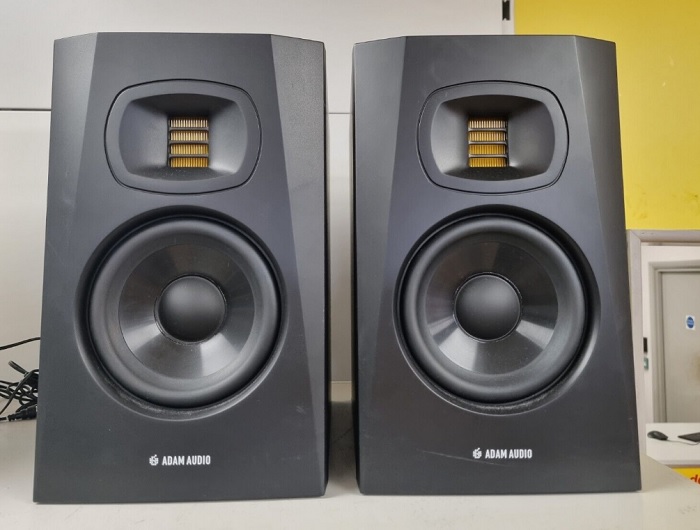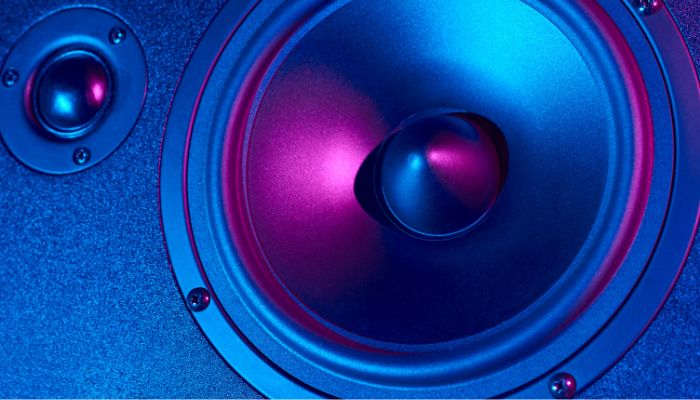The modern music producer needs the right software, headphones and a great pair of monitor speakers.
Whether you’re a bedroom DJ honing your craft and having fun or producing music for class, proper monitor speakers are a must-have for mixing.
Monitor speakers are designed for music through-and-through. They’re built with DJing and music production in mind and will provide crisp, punchy audio with accurate bass and plenty of mid-range body. With good monitors, kicks punch, basslines hum and lead melodies breathe with wider stereo images and warmer tones.
It’s time to ditch those old PC speakers with tinny high-end and poor, flat or non-existent bass!
Proper monitors sound awesome but they’re also a technical tool. They’re named monitor speakers because they allow the listener to monitor what is going on in the mix.
Hi-hats and high-end percussion will be separated from mid-end synths, kick drums from bass lines and vocal melodies from lead parts. By providing an accurate stereo audio image, monitor speakers allow you to really delve into your mix and hear what is going in great detail.
Monitor speakers will help you fine-tune your levels, tighten your beatmatching and altogether elevate your mixing skills.
1. ADAM AUDIO T5V

The award-winning Adam Audio T5V is a modern 5” monitor speaker with ribbon tweeter and 70w of total power. It’s a high-spec speaker for both DJing and audio production and makes a wicked choice for music producers who really want top-quality sound at home.
The Adam Audio T5V sports an innovative ribbon tweeter. This atypical design is quite unique to this speaker and it enables it to produce much louder, clearer high-end with less glassy distortion or other unwanted artefacts. Hi-hats and percussion should cut through the mix with ease but without also sounding harsh.
The rear of the speaker reveals advanced connectivity options including XLR and RCA inputs, which is awesome. There is also a suite of settings that allow you to turn the high frequencies or bass up and down, as well as a volume control.
It’s clear that this is a pro-grade music production monitor that is also designed for studio use and audio production. The enclosure and ribbon tweeter combined create smooth bass and crisp, detailed high-end – it’s tough to beat in terms of audio quality alone.
The U-ART ribbon tweeter is the headline feature here and is equipped with HPS technology, ensuring that frequencies are distributed across a wide, detailed stereo image. This will display hi-hats, vocals, percussion, etc, in their purest form and will allow DJs to really hear what is going on in their mix. The full-range speaker is also well-engineered extending down to some 45Hz, which is more bassy than average for a 5” monitor.
You’d have to say that the T5Vs are loaded to the brim with pro-technology and are at the cutting edge of monitor speaker engineering. They’re built to last and so long as you look after them, they should serve you well for many years!
Pros
- Pro-grade ribbon tweeter
- Full connectivity options
- Adjustable settings
- Plenty of bass and super-smooth highs
Cons
- Priced to match their pro status
2. Pioneer DJ DM-40BT
A DJ equipment list without Pioneer is like a dog without a bone..
The Pioneer DJ DM-40BT is a 4” bi-amped monitor speaker purpose-built for DJing and music production enthusiasts.
Available in black or white, these look the part and they’re predictably loaded with Pioneer technology. They’re 4” monitors, so are slightly smaller than average-sized 5” monitors, but with 40w of power, they pack a punch level with a 5” monitor courtesy of Pioneer’s engineering.
In terms of connectivity, you’ll find RCA and mini-jack inputs. There is also an RCA to mini-jack converter included. Note that if you want to use these with an XLR or TRS-output mixer which doesn’t also have an RCA output then you’ll need an XLR to RCA converter also (they just cost a few quid).
These also have Bluetooth which is compatible with the Qualcomm AptX codec, meaning they handle low-latency audio at high bit rates. This could theoretically enable wireless mixing with compatible mixers or devices – no cables needed!
DJ DM-40BT Features
The DJ DM-40BT speakers features Pioneer’s Groove Technology, which essentially boosts bass and provides smooth but powerful low end. The tweeters are also equipped with 3D audio dispersing technology to provide a wide stereo image with crisp, detailed highs.
This is a superb monitor that will work with most setups and with Bluetooth technology, it’s flexible and future-proof too. It’s also super-easy to set up and will work right out of the box with its no-nuisance design. You could say that the inputs are lacking but still, it will work fine with 90% of mixers even without the use of an adapter. A top speaker purpose-built for DJing and making music.
Pros
- Portable 4” speaker with the power of a 5” speaker
- Pioneer technology for crisp, well-rounded audio
- Bluetooth-enabled
- Trademark Pioneer styling
Cons
- Connectivity is a bit lacking
3. KRK CLASSIC 5
The KRK Classic series are truly iconic. This tried-and-tested classic has won the hearts and minds of many a DJ who simply refuse to switch brand allegiance from KRK – and who can blame them?!
Instantly recognisable, KRK’s black and yellow sub woofer design has become synonymous with their superb monitor speakers. This is actually a re-design of KRK’s Rokit series and brings together 30 years of KRK’s manufacturing experience and prowess into one new range of flexible monitor speakers.
These feature a classic cabinet with 1” tweeter and 5” full-range speaker that are bi-amped with 55w of power. They have an excellent reputation for creating a punchy yet accurate audio image, which is what you want from a good pair of monitor speakers. The 5” version provides 55w but there are 7”, 8” and 10” versions providing up to 300w of KRK power!
Connections here are also fully-featured with both XLR, TRS and RCA inputs. There will be no hassle in connecting any mixer or other audio device to these monitors.
The KRK Classic 5s are all about the audio itself. They’re great for both DJing and audio production and feature 3 controls on the reverse for boosting/attenuating the high-end and low-end, as well as a volume control.
The high-end is crisp and full-bodied without distortion or harsh overtones and the low-end is smooth. A quality built-in limiter will prevent damage to the speakers if you crank up the volume too high.
These are serious monitor speakers that should really go the distance and stay with you until the bitter end!
Pros
- Trademark KRK audio quality
- Full connectivity options
- Powerful with plenty of bass
- Adjustable settings
Cons
- None that we could point out
4. Mackie MR Series
Mackie’s reputation was much enhanced by the critically acclaimed MR series. These bring pro-grade DJ monitor speakers to any DJ’s table or desk at tremendous value.
Sporting a classic tried-and-tested cabinet design and format, Mackie is not trying to reinvent the wheel here. These are robust, powerful and provide detailed, rich around across a wide stereo image.
Despite a simple design, these are still pro-grade monitors with both XLR, TRS and RCA inputs for connection to nearly all mixers and devices. Adjustable settings include acoustic space control and high/low end boosting/attenuation.
The 5” version packs above-average wattage of 50w too, so it should be plenty loud enough for anything from practice to parties.
At their heart, these are basic but powerful monitor speakers with plenty of bass and an ultra-wide, detailed stereo image. The cabinet features custom bracing for low-end focus and response and the tweeters are tuned for fast transient response, really helping hi-hats and percussion cut through the mix.
Pros
- Simple, powerful monitors
- Full connectivity options
- Adjustable settings
- Multiple sizes available
Cons
- High-end not as cutting as other pro-grade monitors (but hardly a problem)
5. Yamaha HS Series
There are few monitor speakers as iconic as the Yamaha HS series and they have made their homes in top studios throughout the world. They’re a superb choice for DJs at any level.
Yamaha’s classic monitor series, the HS series, have really proved themselves worthy amongst the world’s top-spec monitors. They represent the latest and great series of Yamaha’s evolved series of monitors spanning from the NS and MSP series to the new HS series.
Yamaha cites that their experience in drum and piano manufacture has allowed them to tune the HS Series enclosure for maximum bass response and smooth articulation. The 1” tweeter combines with a well-designed full-range speaker to deliver crisp response across the frequency spectrum.
These are equipped with XLR and TRS jack inputs for connection to the vast majority of mixers. Settings on the back allow the speakers to be adjusted for different rooms, and there is also a high/low-end adjustment trim. Note that larger HS series models have a wider array of settings.
Yamaha’s engineering and design dedication is obvious throughout the HS series, and for sonic purity, punchy bass and crisp highs, they are tough to beat.
The woofer, in particular, is designed for smooth bass and it will let kick drums poke through the mix whilst retaining the solidity of deep basslines. The stereo image is tight and wide with minimal loss of bass and other frequencies through the back of the monitor, which is common with other models.
Note that the HS-I version of the HS series simply has an added mounting bracket – there are no other differences!
Pros
- Legendary design
- Full connectivity options
- Very well-designed woofer with plenty of bass
- Adjustable settings
Cons
Priced to match their status
6. ALESIS ELEVATE 5 MKII (Best on a Budget)
Simple, effective and excellent value, the Alesis Elevate 5 MKII speakers are straightforward with quality audio and plenty of bass.
These compact DJ monitors make excellent choices for DJs seeking out a solid power:money ratio with a very solid 80w of total power per speaker. They’re amongst the cheapest 5” DJ monitors around too, and are an excellent choice for experienced DJs and newcomers alike who are looking to add an easy-to-use pair of proper DJ monitors to their setup.
Granted, audio quality likely isn’t up there with the likes of the Adam Audio T5Z and Yamaha HS Series, but still, these will make basslines hum and will give hi-hats and percussion space to breathe. Despite a slimmer price tag, these are still very highly-rated award-winning monitors.
The Elevate 5 MKIIs have TRS and RCA inputs, allowing them to be easily connected to most mixers and other devices. There is also a 3.5mm headphone jack. I’ve tested these with the Traktor Kontrol S2 MK3 playing techno and the audio was super clear with punchy bass and crisp treble.
Alesis has worked hard to equip these monitors with modern technology including waveguide dispersion that provides a wide, crisp and detailed stereo image. A volume control mounted on the front is also convenient and a nice touch.
There is also a bass boost switch which is pretty awesome and does effectively juice up basslines and kick drums.
Pros
- Excellent value monitor speakers
- Useful bass boost switch
- TRS and RCA inputs + 3.5mm headphone jack
- Front-mounted volume control
- Total 80 Watt Fully active system (40W per channel)
Cons
- Lack of adjustable settings
- Slight electrical hum when volume high
Competition is very tight here with the Yamaha HS Series and Adam Audio T5Z series going head to head at the higher end of things. These monitor speakers are some of the best available and will provide any DJ with years of sonic pleasure!
The KRK Classic 5s are superb and represent an excellent balance between quality and value. KRKs have an awesome reputation for a reason and are a favourite among DJs of all kinds. The Mackie MR Series and Alesis Elevate Series bring pro-grade monitors down to grounded prices that punch above their price tag.
Designed for DJs, the Pioneer DM-40BTs are superb and Bluetooth is a useful, if not slightly futuristic touch, that has us guessing whether Bluetooth-enabled mixers are set to become more popular going forward.
DJ Monitors: What to Consider
The Fundamentals of Monitor Speakers
DJ monitor speakers have been perfected over the years and they all share near-identical formats
First and foremost, most DJ monitors are active speakers. That means they contain their own amps – you just plug them into the mains, connect them to your mixer and you’re good to go.
Tweeters and Speakers
A typical DJ monitor speaker is bi-amped, meaning each speaker has two channels; one for a tweeter and one for a full-range speaker.
The tweeter lies at the top of the speaker. Tweeters are small speakers that are engineered to produce high-frequency sounds above the 2kHz mark extending all the way up to 20kHz, which is the highest pitch sound we can hear. Hi-hats, vocals, lead melodies and percussion all involve a lot of high-end tweeter action.
Second, each monitor will contain a larger full-range speaker or woofer sitting below the tweeters. These cover all frequencies but are particularly tuned for the mid-range and lower end.
Modern monitor speakers provide very good bass courtesy of well-tuned enclosures (the box around the speaker).
Speaker Size
Speaker size, or cone size, is the main variable of different monitors. Most monitor speakers come in sizes ranging from 3” to 10”.
The average size is 5” – virtually every range of monitor speakers will have a 5” version. 5” is an excellent compromise between size and volume and easily big enough for the vast majority of home studios.
Larger monitors are suitable for bigger studios and rooms. The bigger the speaker cone, the louder the speaker and more powerful the bass. It’s a pretty linear relationship, bigger is pretty much always louder!
That said, even 5” monitor speakers go pretty loud, easily enough for a small house party or loud mixing session.
Monitor Speaker wattage for room size
Speaker power, measured in watts, goes hand in hand with cone size – bigger speakers need more power.
Most 5” monitors measure around the 40w to 60w mark, 7” around 130w, and 8” and 10” around 200 – 300w at the most. Consider where you will be playing – a small bedroom will be more suited to 5 – 7 inch subs, while larger studios or DJ booths my do better with 8+ inch subs.
If you do want to play your music loud and have the space, it’s best to opt for bigger monitors with higher power handling as these will last longer. Smashing super-heavy basslines at high volumes through a pair of 5” monitors will likely shorten their life expectancy!
Speaker Connections
Most monitor speakers have a mixture of TRS ¼” jack inputs, RCA inputs and XLR inputs.
Many have all 3 of these inputs, enabling easy connectivity to the vast majority of DJ mixers.
Increasingly, monitors are also rolling out with Bluetooth. Maybe this is preempting the increase in Bluetooth-enabled mixers for wireless connectivity, but otherwise, it’s a handy way of connecting other devices like mobile phones.
If you can’t match your mixer directly to a monitor’s inputs then don’t worry as adapters are very cheap.



